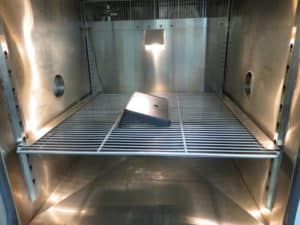ASTM D2126
Standard Test Method for Response of Rigid Cellular Plastics to Thermal and Humid Aging
Micom Laboratories offers the ASTM D2126 test as part of its heat aging testing services. This standard evaluates the effects of several temperatures and humidity levels on rigid cellular plastics through the use of a thermal and humidity cycling test. This method resembles the ASTM D1735 and ASTM D4585 water resistance tests in that they both assess the impact of water and temperature on the samples. However, they differ in the range of experimental conditions. Indeed, there is a high degree of customization of the parameters in ASTM D2126, while there is limited flexibility in the adjustment of the conditions in the other standards.
Use and factors to be considered for thermal and humid aging of rigid cellular plastics:
 The goal of the ASTM D2126 method is to assess the effect of humidity and temperature on rigid cellular plastics through the use of a thermal and humid exposure test. This test consists of evaluating the changes in dimensions and mass of the sample after it has been exposed to a condition of humidity and temperature that is similar to its intended application for a set period of time. The results obtained can serve to compare the performance of a material in a specific situation, to assess the relative performance of various cellular plastics, or to define an acceptance criterion for a material. However, they cannot avail to predict the performance of the specimen nor be used in engineering calculations.
The goal of the ASTM D2126 method is to assess the effect of humidity and temperature on rigid cellular plastics through the use of a thermal and humid exposure test. This test consists of evaluating the changes in dimensions and mass of the sample after it has been exposed to a condition of humidity and temperature that is similar to its intended application for a set period of time. The results obtained can serve to compare the performance of a material in a specific situation, to assess the relative performance of various cellular plastics, or to define an acceptance criterion for a material. However, they cannot avail to predict the performance of the specimen nor be used in engineering calculations.
The main factors that are to be considered when running this test are: the time of exposure, the temperature and the humidity inside the apparatus.
Typical Experimental parameters for ASTM D2126 testing:
The number of samples required is at least two, but preferably three or more. The dimension of the specimen is to be at least 100 mm by 100 mm per thickness supplied (4 in by 4 in per thickness provided). Furthermore, the samples shall be free of cracks with smooth edges, and they must be conditioned to constant mass at a temperature of 23 ± 2 °C and at a relative humidity of 50 ± 10% before they are exposed to the test conditions. The time of exposure may vary from one day to two weeks, and there are a couple of combinations of temperature and relative humidity present in Table 1 of this standard. The range of the temperature is from -73 to 150 °C and the possible values of the relative humidity is either ambient, 50% or 97%. Lastly, all the measurements are done at room temperature. The percentage of the changes is calculated by dividing the difference between the two measurements (initial and final) by the initial value, and the result obtained is then multiplied by 100.
Other test methods related to ASTM D2126:
For additional related test methods, please see ASTM D1735, ASTM D4585. You can also visit our dedicated page for Plastic Testing.
If you have any questions about the ASTM D2126 test, we invite you to contact our material testing lab today. It will be our pleasure to answer your questions and help you with your custom material testing requirements.

